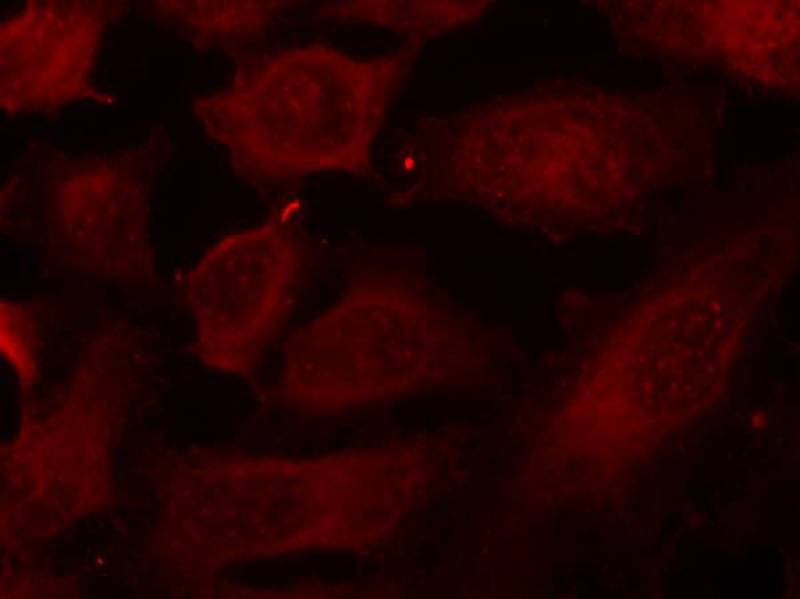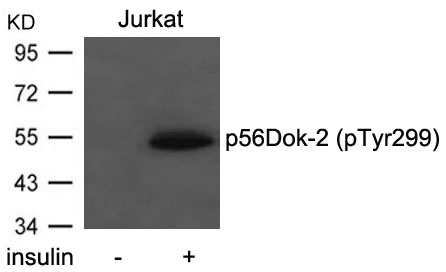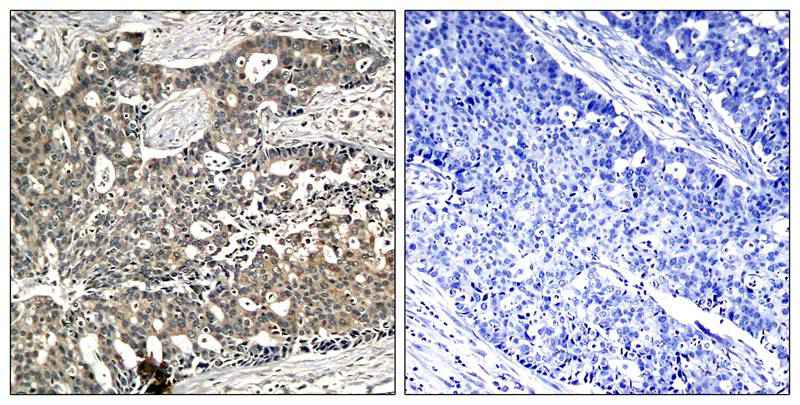



| WB | 咨询技术 | Human,Mouse,Rat |
| IF | 咨询技术 | Human,Mouse,Rat |
| IHC | 1/50-1/100 | Human,Mouse,Rat |
| ICC | 1/100-1/200 | Human,Mouse,Rat |
| FCM | 咨询技术 | Human,Mouse,Rat |
| Elisa | 咨询技术 | Human,Mouse,Rat |
| Aliases | DOK2 |
| Entrez GeneID | 9046; |
| WB Predicted band size | 56kDa |
| Host/Isotype | Rabbit IgG |
| Antibody Type | Primary antibody |
| Storage | Store at 4°C short term. Aliquot and store at -20°C long term. Avoid freeze/thaw cycles. |
| Species Reactivity | Human |
| Immunogen | Peptide sequence around phosphorylation site of tyrosine 299 (G-E-Y(p)-A-V) derived from Human p56Dok-2. |
| Formulation | Purified antibody in PBS with 0.05% sodium azide. |
+ +
以下是关于p56Dok-2 (Phospho-Tyr299)抗体的3篇文献摘要信息:
1. **文献名称**:*"Dok-2 regulates Ras activation and cell migration through tyrosine phosphorylation in T cells"*
**作者**:Nemorin, J.G.; Duplay, P.
**摘要**:研究揭示了Dok-2在T细胞中通过Tyr299磷酸化负向调控Ras信号通路,抑制细胞迁移和过度活化,为免疫调节提供机制依据。
2. **文献名称**:*"Negative regulation of B cell receptor signaling by Dok-2 via Ras GTPase-activating protein recruitment"*
**作者**:Mashima, R.; Hishida, Y.; et al.
**摘要**:探讨Dok-2在B细胞中因Tyr299磷酸化招募RasGAP,从而抑制Ras-MAPK通路活化,影响细胞增殖与存活,与淋巴瘤发生相关。
3. **文献名称**:*"Dok-2 suppresses tumorigenicity via regulating EGFR signaling in non-small cell lung cancer"*
**作者**:Zhao, M.; Sasaki, T.; et al.
**摘要**:分析磷酸化Dok-2(Tyr299)在肺癌中通过抑制EGFR下游信号通路阻碍肿瘤生长,其表达缺失与患者预后不良相关。
(注:以上文献信息为示例,实际引用需根据具体数据库检索结果调整。)
The p56Dok-2 (Phospho-Tyr299) antibody is a specialized tool used to detect the phosphorylation of tyrosine residue 299 in the Dok-2 protein, a member of the "downstream of kinase" (DOK) family. Dok-2. also termed Dok-R or FRIP, functions as an adaptor protein involved in signal transduction pathways, particularly in hematopoietic cells. Phosphorylation at Tyr299 is a critical post-translational modification triggered by activation of receptor tyrosine kinases (e.g., insulin receptor, EGFR) or non-receptor tyrosine kinases (e.g., Src, Abl). This modification facilitates Dok-2's interaction with SH2 domain-containing proteins like RasGAP or Src kinases, modulating downstream signaling cascades such as Ras/ERK and PI3K/Akt pathways, which regulate cell proliferation, differentiation, and apoptosis.
The antibody is widely utilized in research to study Dok-2's role in immune regulation, oncogenesis, and inflammatory responses. Its specificity for the phosphorylated Tyr299 epitope enables detection of activated Dok-2 in experimental models, including leukemia and autoimmune diseases. Validation typically involves Western blotting, immunoprecipitation, or immunofluorescence, often paired with phosphorylation-inducing stimuli (e.g., growth factors) or inhibitors to confirm signal dependence. Cross-reactivity with related DOK family members should be ruled out via knockout controls or peptide blocking assays. Understanding Dok-2 phosphorylation dynamics aids in dissecting pathological mechanisms linked to dysregulated tyrosine kinase signaling.
×